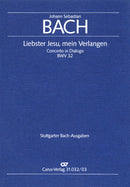| 作曲者 | Johann Sebastian Bach (1685-1750)・ヨハン・セバスティアン・バッハ |
| タイトル | Liebster Jesu, mein Verlangen, BWV 32(ヴォーカル・スコア) |
| サブタイトル | Cantata for the 1st Sunday after Epiphany |
| 出版社 | Carus・カールス |
| シリーズ名 | Stuttgart Bach Edition |
| 楽器編成(詳細) | Soli SB,Coro SATB,Ob,Violin solo,2 Violins,Viola,Basso continuo |
| 品番 | M007042486 |
| 校訂者 | Hans Grischkat |
| 言語 | ドイツ語・英語 |
| 形状 | 24 ページ・19 x 27 cm・86 g・ソフトカバー |
| 演奏時間 | 24分 |
| 作曲年 | 1726年 |
| 出版年 | 1994年 |
| 出版番号 | CV 31.032/03 |
| ISMN | 979-0-007-04248-6 |
| サンプル | https://www.carusmedia.com/images-intern/medien/30/3103203/3103203x.pdf |
The text of the cantata “Dearest Jesus, sore I need Thee” for the 1st Epiphany Sunday 1726 was written by the Darmstadt poet Georg Christian Lehms. It is conceived as a dialog between Jesus and the Faithful Soul. Bach titled his cantata “Concerto in Dialogo” and accordingly, it is structured as a dialog between soprano and bass, set in the voice types that were – not only for Bach – typically used for the soul (soprano) and Jesus (bass). The cantata is based on the narrative of the twelve-year-old boy Jesus in the temple, however, in spite of closely following the gospel text, it is interpreted more widely here: it is through Jesus that the believer finds God’s dwelling. Bach creates a great arch from the opening aria full of yearning and searching through to the joyful duet “Nun verschwinden alle Plagen.” He himself added the four-part closing chorale to the text model, thus communicating the sense of joyous certainty to the congregation of believers.



